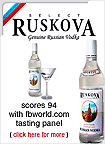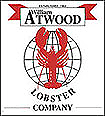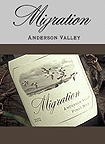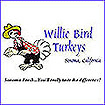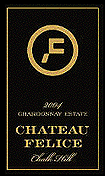Saba:
Japanese for mackerel
Sabayon:
Frothy custard
Sablefish:
This saltwater fish has a soft-textured flesh and a mild flavor.
Its high fat content makes it a good fish for smoking. Called
"Alaskan cod," "Black Cod," "Butterfish,"
and "Skil," although it is neither a cod nor a butterfish.
Saccharine:
This sugar substitute contains 1/8 calorie per teaspoon and
is said to be about 400 times sweeter than sugar
Saffron:
The dried stigmas from the tiny blossom of the small crocus.
Sage:
There are over 500 varieties of this herb that are prized for
their aromatic bitter flavor. Used to season pork, cheese, beans,
stuffings, and sausages.
Sakana:
Japanese for fish
Sake:
Japanese rice wine
Sake:
Japanese for (chum) salmon
Saku:
Japanese for fish meat block
Sakuradai:
Japanese for spring red sea bream
Sakuramasu:
Japanese for cherry salmon
Salmon:
Perhaps the best-known of all fish, they migrate from the seas
into freshwater to spawn. Over the years, some varieties have
become landlocked in lakes.
Salt:
The mineral "sodium chloride."
Same:
Japanese for shark
Samegawa:
Japanese for sharkskin
Sanma:
Japanese for mackerel (saury) pike, (Pacific) saury
Sanshou:
Japanese pepper
Sardine:
The name describing several varieties of weak-boned fish including
the Alewife, French Herring, and Sprat often salted, smoked,
or canned and packed in oil, tomato, or mustard sauce.
Sarsaparilla:
This flavor was originally derived from the dried roots of tropical
smilax vines.
Sasa:
Japanese for bamboo leaf
Sashimi:
Japanese for sliced raw fish
Satoimo:
Japanese for taro, dasheen
Satou:
Japanese for sugar
Sauce:
Thickened stock.
Sauté:
Quickly cooking over high heat while shaking the pan.
Sauterne:
A sweet wine from Sauvignon Blanc or Semillon grapes that have
been infected with a special mold that causes them to shrivel
and leave a sugary fruit with highly concentrated flavors.
Sauvignon
Blanc: An excellent white-wine grape that rivals Chardonnay
and the Reisling.
Savory:
A strongly flavored herb of the mint family. There are two varieties:
winter and summer.
Sawagani:
Japanese for river crab
Sawara:
Japanese for Spanish mackerel
Sayori:
Japanese for halfbeak
Sazae:
Japanese for turbo, turbinate shell
Scald:
To heat milk to just under the boiling point where small bubbles
form along the edge of the pot
Scallop:
A bivalve mollusk with a ribbed, fan-shaped shell. In U.S. markets,
only the adductor muscle, which opens and closes the shell is
available
Scampi:
The Italian name for the tail portion of any of several varieties
of miniature lobsters.
Screwdriver:
An alcoholic beverage made with orange juice and vodka
Scotch:
This distinctive liquor, made only in Scotland, uses barley
for flavoring instead of corn
Scrod:
This is the name for young cod (and haddock) that weight less
that 2.5 pounds. It is a popular fish from the Pacific and the
North Atlantic with a lean, firm, white flesh. "Haddock,"
"hake," and "pollock" are close relatives
of the cod.
Scup:
Also know as "porgie" or "sea bream." These
fish are generally lean, and coarse-grained. it is often grilled,
poached, and pan-fried.
Sea Bass:
A term used to describe a number of lean to moderately fat marine
fish, most of which aren't actually members of the bass family.
Sea Bream:
Also know as "scup." These marine fish are generally
lean, and coarse-grained
Sea Devil:
This large low-fat, firm-textured salt-water fish has a mild,
sweet flavor that compares with lobster. Also called "angler
fish" "monkfish," and "goosefish."
Sea Perch: This important commercial fish is
a member of the rockfish group. Also known as "ocean perch,"
although it is not a true perch.
Sea Trout:
An anadromous (spawns in fresh water) brown trout that spends
part to its life cycle in the sea. They have meat that is pink
to red in color and is very comparable to salmon
Sear:
To cook over high heat for a short period to lock in juices
(steak) or achieve quick coloring (chicken skin).
Seburuga:
Japanese for sevruga
Seigo:
Japanese for young sea bass (12 yrs. old)Selfrising: All purpose
flour fortified with baking powder as a leavening agent.
Seltzer:
A flavorless, naturally effervescent water
Semisweet:
Sweetened chocolate, also known as bittersweet chocolate.
Semolina:
Flour milled from durum wheat, similar to farina.
Seri:
Japanese for water dropwort
Serori:
Japanese for celery
Shad:
Small, delicate saltwater fish related to the alewife, herring,
and sardine. They are larger than herrings and spawn in fresh
water. Some species have been landlocked and live in freshwater
lakes.
Shako:
Japanese for mantis shrimp, squilla
Shamoji:
Japanese for spatula
Shari:
Japanese for sushi rice
Shark:
A flavorful, low-fat fish that includes varieties such as Leopard,
Mako, Spiny Dogfish, Soupfin and Thresher
Sheeps
head: A saltwater fish belonging to the wrasse family.
Also called "Fathead," and "Redhead." Its
meat is white, tender, and lean.
Sherry:
This famous Spanish fortified wine is also made in the U.S.
Shibaebi:
Japanese for shiba shrimp
Shiira:
Japanese for dolphinfish
Shiitake:
Japanese for shiitake mushroom
Shijimi:
Japanese for freshwater clam
Shimaaji:
Japanese for striped jack, yellow jack
Shimeji:
Japanese for shimeji mushroom
Shinko:
Japanese for young gizzard shad
Shio:
Japanese for salt
Shiokara:
Japanese for salted fish guts
Shirako:
Japanese for milt, soft roe
Shirasu:
Japanese for young sardines
Shirauo:
Japanese for whitefish, whitebait, icefish
Shiromi:
Japanese for whitish fillet
Shirouo:
Japanese for ice goby
Shishamo:
Japanese for shishamo smelt
Shiso:
Japanese for perilla (seeds)
Shitabirame:
Japanese for sole
Shokuchuudoku:
Japanese for food poisoning
Sho'ochuu:
Japanese clear distilled shochu sprit
Shortening:
Oil that is hydrogenated to alter the melting temperature so
it remains solid at room temperature
Shouga:
Japanese for sliced ginger
Shrimp:
American's most valuable and popular shellfish. This ten-legged
crustacean got its name from the English word which means "puny
person."
Sift:
Aerating and mixing dry ingredients (especially flour) by passing
the powder through a mesh screen.
Siliconepaper:
A heavy grease-proof paper widely used for lining cooking pans
Silver
Hake: A small gray and white saltwater fish that is
also called the "whiting." This low-fat fish, which
is related to "cod" has a tender white fine-textured
flesh and a flaky, delicate flavor.
Silver
Salmon: This high-fat variety of salmon provides a
firm-textured, pink to orange-red flesh. Also called the "coho
salmon."
Simmer:
To cook in liquid over low heat, slow agitation.
Simplesugar:
Also called single sugar and stick syrup, such as glucose, dextrose
etc.
Singapore Sling: A cocktail of gin, cherry brandy, and lemon
juice.
Skate:
This kite-shaped fish features edible fins. The flesh is firm,
white, and sweet, similar to the texture and taste of scallop.
Skil:
This saltwater fish has a soft-textured flesh and a mild flavor.
Its high fat content makes it a good fish for smoking. Also
"black cod" and "sablefish," although it
is not a cod.
Skipjack
Tuna: Also called the "oceanic bonito," "watermelon,"
and "Arctic bonito," this small tuna (6 to 8 pounds)
has a light-colored meat similar to yellowfin. The Japanese
call this fish "katsuo" and the Hawaiians call it
"aku."
Sloe
Gin: A liqueur made by steeping gin with crushed sloes
Smelt:
A rich and oily mild-flavored fish. Popular varieties of smelt
include "Eulachon" and "Whitebait." The
eulachon is called the "candlefish" because Indians
sometimes run a wick through their high-fat flesh and use them
for candles.
Snail:
Popular since prehistoric times, the creature was greatly favored
by ancient Romans who set aside special vineyards where they
could feed and fatten.
Snapper:
There are a few hundred species of this lean, firm-textured
saltwater fish, 15 or so which are available in the U.S.
Soba:
Japanese for buckwheat noodle, brank noodle
Sockeye
Salmon: Prized for canning, it has a firm, red flesh.
Also known as the "redeye salmon."
Sodiumchloride:
A compound (salt) used for seasoning and preserving foods.
Soft
Drink: Any drink that is non-alcoholic.
Softshell
Crab: This is actually the blue crab caught just after
molting (discarding its shell). This crab is found along the
Gulf and Atlantic coasts.
Sole:
A popular flatfish with a delicate flesh with a firm, fine texture.
The best-known variety is "Dover" (also called "channel
sole
Sorrel:
Any of several varieties of the hardy perennial herb from the
buckwheat family. Also known as "dock." The most strongly
flavored variety is "sour dock
Spice:
Flavors obtained from barks, roots, seeds etc...
Spicy:
Terminology used for food with a hot sensation, also known as
fire or hot.
Spot:
A small fish (approximately 1.5 pounds) belonging to the drum
family. In 1925, these fish appeared in New York harbor in such
vast numbers that they clogged the condenser pumps of the electric
company and caused a blackout.
Squid:
This ten-armed cephalopod is related to the octopus and the
cuttlefish
Steaktartar:
Thinly sliced or ground seasoned uncooked lean meat
Steam:
To cook using the vapor produced when water boils
Stew:
Cooking vegetables and meat or poultry for long period of time
in a covered pot.
Stirfry:
Cooking vegetables alone or with meat or poultry over high heat
in oil, stirring frequently as to retain the crispness of the
vegetables, this is usually done best in a wok.
Stock:
Flavored liquid produced by cooking vegetables, meat, bones,
etc. also known as broth.
Striped
Bass: This fish is found along the Atlantic coast.
It features six to eight horizontal stripes and provides a moderately
fat, firm flesh with a mild, sweet flavor.
Sturgeon: A name for various migratory species of fish known
for rich, high-fat flavor, firm texture, and excellent roe.
Su
(yonezu): Japanese for (rice) vinegar
Sucker: A name popularly applied to various
types of freshwater fish closely related to carp. They live
and feed near the bottoms of streams. They may be cooked in
any way appropriate for other fish.
Sucrose:
Sweet crystals (regular sugar) obtained from the juices of sugar
cane and sugar beet.
Sudachi:
Japanese for citron
Suet:
Fat from the internal organs (kidneys) of cows and sheep, characteristics
are crumbly and dry, used in steamed puddings, also known as
tallow and atora.
Suimono:
Japanese for clear soup
Sujiko:
Japanese for salmon roe
Sumashijiru:
Japanese for clear soup
Sumiika:
Japanese for squid, cuttlefish
Sunfish:
Any of a number of North American freshwater fish closely related
to the perch. Known for their bright, sunny colors and interesting
shapes, popular varieties include "Bluegill," "Crappie,"
and "Calico Bass
Sunomono:
Japanese for vinegared pickles
Suppon:
Japanese for softshelled turtle
Surimi:
Imitation crabmeat processed from fish.
Surumeika:
Japanese for common squid
Sushioke:
Japanese for sushidish
Shutou:
Japanese for salted bonito guts
Suzuki:
Japanese for sea bass, Japanese seaperch
Sweat:
Slowly cooking over low heat, covered.
Swordfish:
A saltwater food and sport fish with mild-flavored, moderately
fat flesh. The flesh is red, dense, and meat-like











